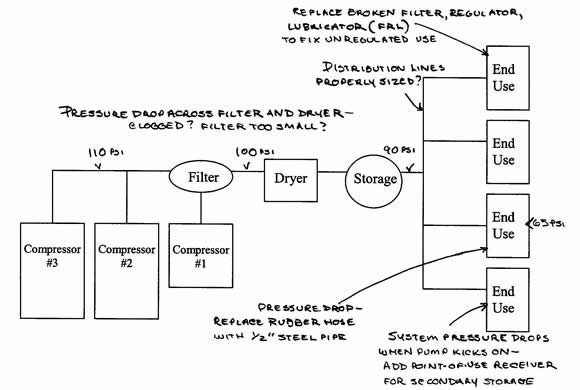Top Compressed Air Energy Saving Options
Metal casters, pulp and paper mills, and mines all identified compressed air as a common, high-energy use in their facilities. Compressed air, often called the fourth utility, is inefficient—as much as 80 to 90 percent of the electrical energy used by an air compressor is lost as heat.
MnTAP recently arranged for compressed air assessments at two paper mills and two metal casters in Minnesota. Frank Moskowitz, a consultant with Draw Professional Services and a certified U.S. DOE trainer who conducted the assessments, provided each company with a list of recommended actions to reduce energy use related to compressed air. All of the facilities had these three recommendations in common: add storage, add sequencing and remove all inappropriate uses. How does your facility compare?
Add Storage
Use horsepower for base load and storage to meet peak demand. If a compressed air system is sized for peaks then the compressors are idle most of the time—which means they are operating inefficiently and inflating energy demand.
If you’ve got a BAU (a not-so-technical acronym for big air user, equipment that demands a lot of compressed air) determine whether it should have a point-of-use receiver to store compressed air and eliminate the peak demands that drop overall system pressure. A drop in system pressure can make air tools function less efficiently, adversely affecting production.
Make sure your primary storage is adequate. You want to be sure your system is designed with three to five gallons of storage per cubic feet per minute (cfm) flow.
You save one percent of compressor energy use for each two PSI drop at the compressor.
Add Sequencing
If you have a multiple compressor system, are all of your compressors working hard or hardly working? Compressors are most efficient when they operate fully loaded. Every online compressor should be at full load except one that runs partly loaded to match supply with demand (trimming). A variable speed drive is ideal for trimming because it actually changes the motor’s speed, which will reduce energy use.
According to Moskowitz, a modulating compressor operating at 40 percent output could still be consuming 80 percent of its power. If possible, use network controls so that the compressors communicate, working together to minimize energy use.

To start evaluating your compressed air system, find engineering blue prints of the system or draw up a simple block diagram to show both the supply and demand sides of your system. The block diagram above notes some common opportunities to improve efficiency.
Remove all Inappropriate Uses
Remove all inappropriate uses of compressed air and substitute another energy source. Check your facility’s uses of compressed air against this sample list of inappropriate uses and best alternatives.
- Atomizing. For example, use high-volume low-pressure air guns.
- Cooling personnel or electrical cabinets. Use air conditioning or fans.
- Parts drying. Use blowers, heat or microwaves.
- Open blowing. Use blowers instead. Or, if compressed air must be used, install engineered low-volume high-velocity nozzles with eductors to amplify air flow.
- Sparging or mixing. Use blowers instead.
- Vacuum generation. Use a vacuum pump.
Stora Enso
Stora Enso, a paper mill in Duluth, was one of the companies to receive an audit. The company had a good sense for where the inefficiencies were in its compressed air system, but the audit showed staff how to present the data to best assess cost-benefits.
“The audit was a good opportunity to have an outside, third-party auditor come on site to assess potential losses and energy-saving opportunities,” said Karen Turnboom, fiber/materials/energy manager at Stora Enso.
After the audit, the company made minor modifications right away, fixing inappropriate uses and decreasing the volume of air used in the system. One small, easy change was to replace the nozzles of compressed air hoses with low-volume high-velocity nozzles. Additional projects will be submitted for capital funding.
For more information about maximizing the energy efficiency of your air compressor system, contact MnTAP at 612-624-1300 or 800-247-0015 for assistance.